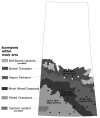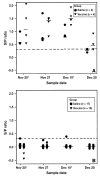Seroprevalence and risk factors for infection with West Nile virus in Saskatchewan horses, 2003
- PMID: 17955899
- PMCID: PMC1940272
Seroprevalence and risk factors for infection with West Nile virus in Saskatchewan horses, 2003
Abstract
The primary objectives of this study were to determine the seroprevalence of West Nile virus (WNV) infection of horses in Saskatchewan in 2003 and to identify risk factors for the infection. Blood samples were collected in August and October from 212 horses in 20 herds in 5 geographic zones. After accounting for within-herd clustering, the proportion of horses that had been infected with WNV, as determined by IgG and IgM antibody response, was 55.7% (95% confidence interval, 44.9% to 65.8%). The proportion of antibody-positive horses differed among herds (0% to 100%) and across ecoregions (20% to 76%). Horses in southern ecoregions were more likely to have either IgM antibodies or IgG concentrations suggesting infection than were horses in northern ecoregions. The use of mosquito-control measures was associated with decreased risk. After accounting for ecoregion, there was no difference between recipients of an inactivated WNV vaccine and nonrecipients in the occurrence of antibodies reflecting natural infection.
Les objectifs principaux de cette étude étaient de déterminer la séroprévalence de l’infection par le virus du Nil occidental (WNV) en 2003 chez les chevaux de la Saskatchewan et d’identifier les facteurs de risque pour cette infection. Les échantillons de sang ont été prélevés en août et en octobre sur 212 chevaux dans 20 troupeaux dans 5 zones géographiques. Après avoir pris en considération le regroupement intra-troupeau, la proportion de chevaux qui avaient été infectés par le WNV, tel que déterminée par la réponse humorale en IgG et IgM, était de 55,7 % (intervalle de confiance 95 %, 44,9 % à 65,8 %). La proportion de chevaux possédant des anticorps différait parmi les troupeaux (0 % à 100 %) et variait entre les régions (20 % à 76 %). Les chevaux provenant des régions du sud étaient plus susceptibles d’avoir des concentrations d’IgM ou d’IgG suggestives d’une infection que les chevaux dans les régions du nord. L’utilisation de méthodes de réduction des moustiques était associée à un risque réduit. Après avoir pris en considération la région, il n’y avait pas de différence entre le receveur d’un vaccin WNV inactivé et un animal non-vaccciné pour ce qui est de l’occurrence d’anticorps démontrant une infection naturelle.
(Traduit par Docteur Serge Messier)
Figures


Similar articles
-
A case-control study of factors associated with development of clinical disease due to West Nile virus, Saskatchewan 2003.Equine Vet J. 2007 Nov;39(6):498-503. doi: 10.2746/042516407X248476. Equine Vet J. 2007. PMID: 18065306
-
Seroprevalence of West Nile virus in feral horses on Sheldon National Wildlife Refuge, Nevada, United States.Am J Trop Med Hyg. 2011 Apr;84(4):637-40. doi: 10.4269/ajtmh.2011.10-0467. Am J Trop Med Hyg. 2011. PMID: 21460023 Free PMC article.
-
Seroprevalence of West Nile virus in Iran.Vector Borne Zoonotic Dis. 2013 Aug;13(8):586-9. doi: 10.1089/vbz.2012.1207. Epub 2013 May 22. Vector Borne Zoonotic Dis. 2013. PMID: 23697768
-
West Nile virus in the United States (1999-2005).J Am Anim Hosp Assoc. 2006 May-Jun;42(3):170-7. doi: 10.5326/0420170. J Am Anim Hosp Assoc. 2006. PMID: 16611928 Review.
-
West Nile Virus: is a vaccine needed?Curr Opin Investig Drugs. 2010 Feb;11(2):139-46. Curr Opin Investig Drugs. 2010. PMID: 20112163 Review.
Cited by
-
Predictive risk mapping of West Nile virus (WNV) infection in Saskatchewan horses.Can J Vet Res. 2011 Jul;75(3):161-70. Can J Vet Res. 2011. PMID: 22210991 Free PMC article.
References
Publication types
MeSH terms
Substances
LinkOut - more resources
Full Text Sources
Medical
